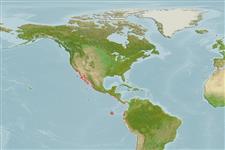>
Eupercaria/misc (Various families in series Eupercaria) >
Sciaenidae (Drums or croakers)
Etymology: Menticirrhus: Latin, mentum = beard, chin + Latin, cirrus = curly.
More on author: Girard.
Environment: milieu / climate zone / depth range / distribution range
Ökologie
seewasser demersal; tiefenbereich ? - 14 m (Ref. 9118). Subtropical; 37°N - 21°S, 123°W - 68°W
Eastern Pacific: California, USA to Peru.
Size / Gewicht / Alter
Maturity: Lm ? range ? - ? cm
Max length : 71.0 cm TL Männchen/unbestimmt; (Ref. 2850); max. veröff. Gewicht: 3.9 kg (Ref. 2850); max. veröff. Alter: 8 Jahre (Ref. 56049)
Occur along sandy shores and in bays, usually in sandy surfs of exposed outer coast. Usually found in small groups; larger fish are more solitary. Feed on sand crabs, other small crustaceans, and worms (Ref. 9118). Spawning begins in July (Ref. 9118). Pelagic spawners (Ref. 56049). Cannot produce croaking sounds due to lack of air bladder. Considered a good food fish and is common in markets (Ref. 9118).
Life cycle and mating behavior
Geschlechtsreife | Fortpflanzung | Ablaichen | Eier | Fecundity | Larven
Pelagic spawner (Ref. 56049).
Eschmeyer, W.N., E.S. Herald and H. Hammann, 1983. A field guide to Pacific coast fishes of North America. Boston (MA, USA): Houghton Mifflin Company. xii+336 p. (Ref. 2850)
IUCN Rote Liste Status (Ref. 130435: Version 2024-1)
Bedrohung für Menschen
Harmless
Nutzung durch Menschen
Fischereien: kommerziell; Sportfisch: ja
Tools
Zusatzinformationen
Download XML
Internet Quellen
Estimates based on models
Preferred temperature (Ref.
123201): 17.8 - 28.9, mean 23.6 °C (based on 262 cells).
Phylogenetic diversity index (Ref.
82804): PD
50 = 0.5020 [Uniqueness, from 0.5 = low to 2.0 = high].
Bayesian length-weight: a=0.00933 (0.00533 - 0.01633), b=3.03 (2.88 - 3.18), in cm total length, based on LWR estimates for this species & (Sub)family-body (Ref.
93245).
Trophic level (Ref.
69278): 3.3 ±0.50 se; based on food items.
Generation time: 2.9 ( na - na) years. Estimated as median ln(3)/K based on 1
growth studies.
Widerstandsfähigkeit (Ref.
120179): mittel, Verdopplung der Population dauert 1,4 - 4,4 Jahre. (tm=2.5; tmax=8).
Fishing Vulnerability (Ref.
59153): Low to moderate vulnerability (34 of 100).
